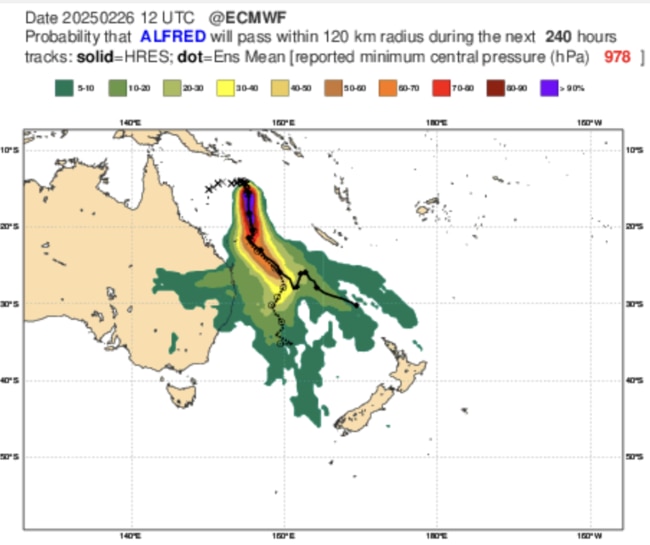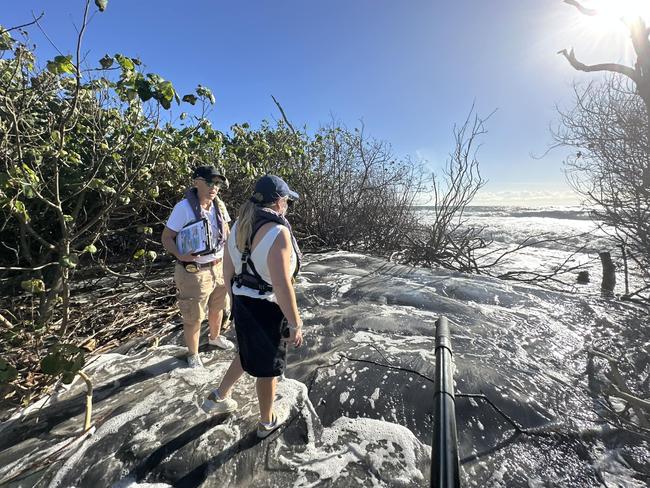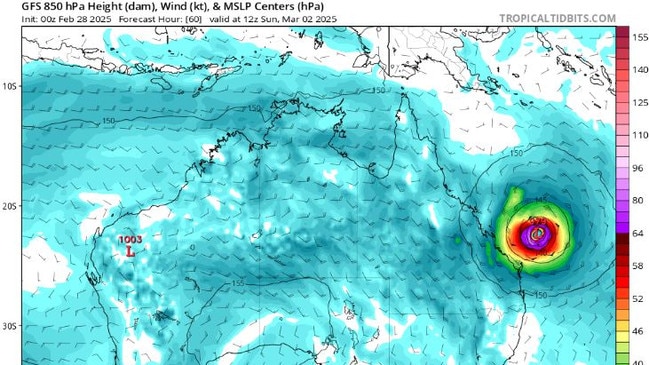Cyclone Alfred could hit south east Queensland including Sunshine Coast and Gold Coast
Rising swells and powerful waves generated by Alfred are eroding beaches in densely populated Sunshine Coast and Gold Coast.

Densely-populated southeast Queensland is facing the first direct impact in decades from a powerful tropical cyclone, with its pristine beaches expected to be pounded by heavy swell.
Category-3 Cyclone Alfred, packing destructive winds of up to 280km/h, could hit communities south of Bundaberg from next week.
Not since Cyclone Cliff in 1981 has a maelstrom threatened to cross the coast so far south, triggering alerts for tidal surges and erosion reaching to as far south as the Gold Coast.
Beaches from the Fraser Coast adjacent to Bundaberg to the busy Sunshine Coast are set to be battered by big seas as the cyclone approaches the coast on Sunday.
However, forecasters caution that it may yet slip away from the seaboard. It was centred about 750km northeast of Mackay late on Friday.
Dean Narramore from the Bureau of Meteorology predicted conditions would deteriorate from Saturday.
“Any beach activities could present danger because you’ll have big, messy waves and big rips,” the forecaster said.
“We could see water levels at high tide exceed the highest tide of the year, possibly by up to half a metre over the weekend.

“Because of that we do have a coastal hazard warning for abnormally high tides and damaging surf extending from Bundaberg down to the New South Wales border, which of course includes the Sunshine Coast and Gold Coast.”
Well offshore the system has already triggered damaging swell and waves, threatening to rip through popular Sunshine Coast destination Bribie Island as rising tides have begun eroding the narrow land mass.
Mr Narramore said there was a “big risk” of further erosion over the weekend to beaches and coastal infrastructure across Queensland’s southeast.
“Along with the high tide waves could get up to three, even four metres from next week,” he said.
“So that could lead to widespread coastal erosion from about Fraser Island (K’gari) all the way down to northern NSW.”
“If you live on the beach we could see those waves coming up onto the dunes and into those low lying areas around car parks and surf clubs.”
A hazardous marine wind warning had been issued, with gales set to batter exposed islands including K’gari, Stradbroke Island, Moreton Island and Bribie Island.
Concern had also been raised for the Gold Coast, where predicted high tides could cause drains to backup, unleashing flooding, Mr Narramore said.

The system would likely remain offshore until next Wednesday, but there was significant uncertainty over whether it would then track towards the coast.
“There’s a couple of scenarios where it could hit southeast Queensland or even northern NSW,” Mr Narramore said.
“But other models show it moving further south into the Tasman Sea or even moving south-westerly towards New Zealand.”



To join the conversation, please log in. Don't have an account? Register
Join the conversation, you are commenting as Logout